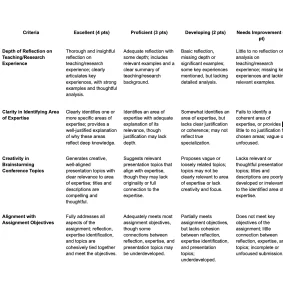IDT400x:
Course Evaluation & Capstone Project
Link to IDD:
Safe Drone Flying: A Comprehensive Guide for Enthusiasts
Minicourse Features:
Interactive Learning Modules: Participants will engage in dynamic modules covering key topics such as airspace regulations, safety protocols, and operational techniques. Each module will include multimedia elements, such as videos and animations, to enhance understanding.
Drone Flight Simulations: Learners will complete hands-on simulation exercises to practice basic and advanced drone maneuvers, ensuring they acquire practical drone flying skills.
Certification Guidance: A step-by-step guide on obtaining drone certification, including preparation for FAA tests, licensing information, and access to relevant resources. This ensures participants are prepared to become licensed drone pilots.
Community Engagement: Discussion forums and collaborative exercises will encourage learners to share experiences, troubleshoot issues, and discuss best practices in a peer-supported environment.
LMS Declaration:
I have selected Google Classroom as the LMS for this course. Google Classroom offers a streamlined, user-friendly platform that integrates seamlessly with various Google Workspace tools, supporting multimedia integration, interactive activities, and collaborative learning environments. These features align well LMS Features Supporting the Course:
✅ Integrated Course Tools:
Google Classroom allows for easy organization of course materials through modules, assignments, and quizzes. The platform supports built-in assessment tools, enabling a structured and straightforward course design.✅ Collaborative Learning Environment:
With Google Classroom’s integration with Google Docs, Slides, and Forms, learners can collaborate on group projects, participate in discussions, and share their insights through comments and peer feedback.✅ Accessibility and Progress Tracking:
Google Classroom offers tools for monitoring student participation, tracking assignment completion, and providing timely feedback. The platform also integrates with Google Meet for virtual discussions and synchronous learning opportunities.
Training Resources:
📖 Google Classroom Teacher Center:
A comprehensive guide covering all aspects of setting up, managing, and engaging students in Google Classroom. Available at Google for Education Teacher Center.🎥 Google for Education YouTube Channel:
Offers tutorials on using Google Classroom effectively, including creating assignments, managing class discussions, and integrating with other Google tools. This is particularly helpful for visual demonstrations of platform features.
Click here to see the survey.
Creating this survey was an opportunity to focus on how learners will react to both the course content and delivery. Creating the survey at this point in the design process provides an opportunity for the designer to re-center the needs of learners while conceptualizing content and delivery. It also means that the survey will be ready to distribute on time once learners start completing the course.
See the survey here
This module is associated with CLO 2: Demonstrate advanced drone maneuvers and CLO 3: Identify and mitigate risks in drone flying.
It will be included at the end of Unit 2 and will address both unit goals:
- By the end of Unit 2, learners will be able to perform advanced drone maneuvers safely.
- By the end of Unit 2, learners will be able to identify potential hazards and apply risk mitigation strategies.
In this module, learners will view a tutorial on advanced drone flying techniques, analyze real-world case studies of drone incidents, and create a risk mitigation plan. After taking this assessment, they will perform the advanced maneuvers in a simulated environment and submit a written risk mitigation plan.
Link to Discussion
Course Learning Outcomes
- Understand the fundamental principles of safe drone flying, including airspace regulations and safety guidelines.
- Demonstrate proficiency in drone operation techniques and maneuvers through practical exercises and simulations.
- Identify potential hazards and risks associated with drone flying and implement appropriate safety measures to mitigate them.
- Navigate the process of obtaining necessary certifications and licenses for advanced drone operation.
- Apply ethical and responsible drone flying practices to protect personal safety, privacy, and the environment.
Module/Lesson Learning Objectives
- Learners will be able to identify key airspace regulations and explain their importance for drone operation.
- Learners will be able to recognize common drone flying hazards and suggest appropriate mitigation strategies.
Learning Materials and Activities
- Video lectures on drone safety and airspace regulations.
- Interactive modules for practicing drone maneuvers.
- Case studies and scenario-based exercises on risk mitigation.
- Guided readings on certification requirements.
Discussion 1
Prompt:
Research the official drone flying regulations in your country or region. Share the following details in your post:
- Country/region and relevant regulatory body (e.g., FAA for the United States).
- Basic airspace regulations applicable to recreational drone flying.
- Any recent updates or changes in drone safety laws.
Learning Objective:
Understand and apply fundamental drone airspace regulations relevant to your region.
Information for Participation Requirements:
Provide a brief introduction on where to find official drone regulations and why staying up to date with these laws is crucial for safe flying.
Discussion 2
Prompt:
Describe a situation—real or hypothetical—where you encountered or could encounter a safety issue while flying a drone. Discuss:
- The potential hazard.
- How you addressed or would address the issue.
- Any lessons learned from the experience.
After posting, respond to at least two peers by offering additional suggestions or feedback on their safety solutions.
Learning Objective:
Identify potential hazards and risks associated with drone flying and suggest appropriate safety measures.
Information for Participation Requirements:
Provide examples of common drone hazards and strategies for managing them effectively.
Assignment
Prompt:
Reflect on your personal journey as a drone enthusiast and operator. In your reflection, address the following:
Background Reflection (300-400 words):
- Describe your experience with drone flying. What motivated you to start?
- What challenges have you faced?
- Share any notable experiences that stand out in your journey.
Area of Expertise (150-200 words):
- Identify a particular area where you feel confident in your drone flying skills (e.g., aerial photography, risk management, technical operation).
- Explain why you feel knowledgeable in this area and how this expertise could be valuable to other drone enthusiasts.
Potential Presentation Topic (150-200 words):
- Brainstorm ideas for a potential conference presentation based on your expertise.
- Include a presentation title and a brief description of what the presentation might cover.
Learning Objectives:
- Reflect on personal growth and experience in drone flying.
- Identify areas of expertise and potential knowledge-sharing opportunities.
Instructions for Submission:
Submit your assignment through the course platform following the rubric provided.
Reflection
This activity is designed to help learners apply their understanding of drone regulations and safety measures while reflecting on their personal experiences. By engaging in discussions and identifying areas of expertise, participants deepen their learning and gain insights from peers. This peer-based learning experience enhances knowledge-sharing and promotes a community of responsible and skilled drone operators.
Link: Rubrics
Discussion Board
Prompt:
Find at least one drone-related event or certification program that is currently open for registration. Share the following information in your comment:
- Event or certification title and date
- Relevant topics or skills covered
- Registration deadline
Assignment
Prompt:
Reflect on your journey as a drone enthusiast or operator. What drone models have you flown the most? What challenges or learning experiences stand out in your flying practice?
In 300-400 words, summarize your drone flying experience. Include details such as the types of drones you’ve flown, any specific flight projects you’ve worked on, or areas where you’ve gained significant skills (e.g., photography, racing, safety protocols).
Based on your reflection, identify one or two areas where you have developed a deep understanding or expertise in drone operation. These could be related to specific flying techniques, safety measures, or regulatory knowledge.
In 150-200 words, describe the area(s) of expertise you identified. Explain why you consider yourself knowledgeable in this area and how this expertise might be valuable for other drone enthusiasts.
In 150-200 words, brainstorm potential topics for a drone-related presentation you could give to a community of drone pilots. Consider questions like: What unique insights could you share? How can your experience benefit other enthusiasts?
Include at least one potential presentation title and a brief description of what your presentation might cover.

Learning Theory:
In designing my drone minicourse, the learning theory that most influenced my decisions was Experiential Learning Theory (ELT). This theory emphasizes learning through direct experience, which is highly relevant for a hands-on subject like drone operation. ELT guided me to create learning objectives that focus on practical, real-world applications, ensuring that learners can immediately apply the concepts to their drone flying experiences.
For example, I developed activities where learners practice basic drone maneuvers in real or simulated environments, allowing them to apply new knowledge to their flying skills. I also included reflective tasks, encouraging students to critically think about their learning process, including how their current flying techniques can improve based on the course content.
Integrating Experiential Learning Theory made the course more learner-centered and applicable. I incorporated video demonstrations and flight logs, allowing students to document their learning journey, share their progress, and receive peer feedback. This approach ensured that every activity was grounded in practical experience, which is key for learners who are building or refining their drone operation skills.
ID Model:
In developing my drone minicourse, I followed the ADDIE (Analyze, Design, Develop, Implement, Evaluate) instructional design model. This model emphasizes a systematic approach, starting with analyzing learners’ needs and working through stages that ensure all course components align with the desired outcomes.
I began by identifying the core skills learners need to fly drones safely and effectively. From there, I designed objectives and assessments that would allow students to demonstrate their mastery of these skills. For example, I created assessments where students perform specific drone maneuvers, document their flight experiences, and reflect on their improvements over time.
The ADDIE process influenced the course’s structure by ensuring each phase of development aligned with the overall learning objectives. This resulted in clear, focused lessons that cater to both novice and experienced drone pilots. A challenge I faced was maintaining flexibility to accommodate different learner backgrounds while staying true to the course goals. However, the ADDIE model allowed me to implement varied delivery methods, including video tutorials, hands-on practice, and peer discussion, catering to diverse learning preferences.
Ultimately, the ADDIE model ensured that the course remained well-structured and goal-oriented, with a focus on practical application and continuous evaluation to meet the needs of all learners.
Project Submission
Link to screencast presentation:
Link to portfolio:
Instructional Design
Link to IDD:
IDD
Minicourse link and access information:
Link to Google Classroom Minicourse:
https://classroom.google.com/u/2/w/NzU0NTYyNzUxNjMz/t/all
Login to LMS (Google Classroom):
Username: id.guxarts@gmail.com
Password: instructionaldesign2025
Course Evaluation
The course was evaluated using participant feedback through Kirkpatrick Level 1 and Level 2 surveys. Results and adjustments based on this evaluation have been discussed in the screencast presentation. Changes were made according to both self-assessment and peer feedback to improve the overall learning experience.
License and Credits
All of the content in this course is licensed under the Creative Commons Attribution-NonCommercial 4.0 International License. You are free to share and adapt this work as long as appropriate credit is given and it is not used for commercial purposes. For more details, please read the full license here: https://creativecommons.org/licenses/by-nc/4.0/
© 2025 Gustavo Javier Santamaría Echeverría
Powered by Guxarts
Check out the other courses





